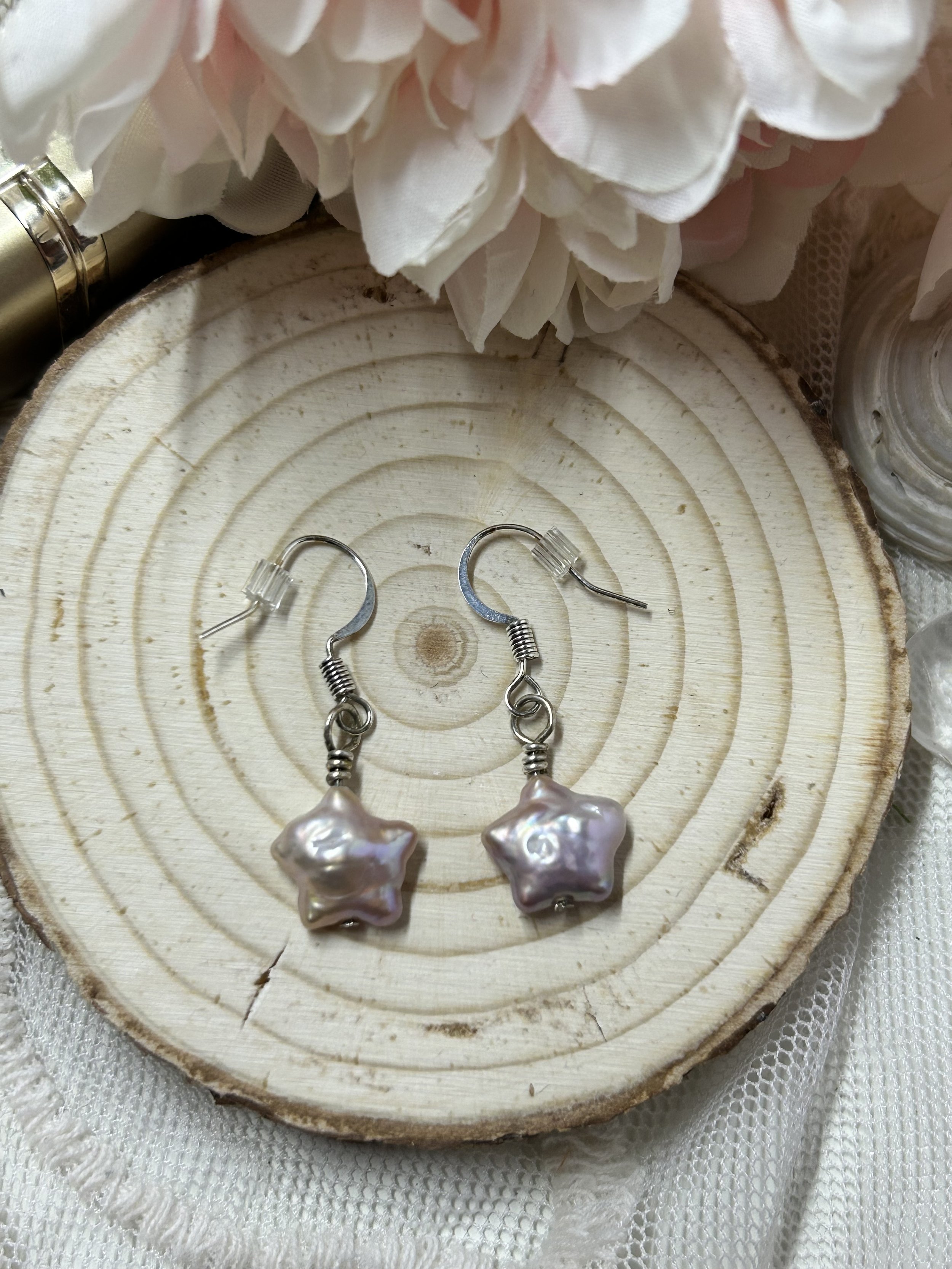Star-'Shaped Freshwater Pearl Earrings #2
Stone: Freshwater Pearl
Hook Material: Silver Plated
A pearl forms around any kind of irritant inside of a clam. If a parasite enters a clam, the clam coats it in nacre (creating a pearl). This works as a defense mechanism to keep the parasite from taking over the clam. However, irritants can also include things like grains of sand and fragments of shell. Star pearls are cultured pearls, meaning that the production of them is human-aided. People insert star-shaped seeds (or irritants) carved from shell and the clam coats it in nacre, forming a pearl around the star shape. The star pearls in these silver plated necklaces are also not the traditional white color. This does not mean they are dyed though. The color of a pearl is determined by the DNA of the clam, the temperature of the water, and the minerals in the water. Pearls naturally come in a variety of colors like white, pink, purple, cream, rose gold, champagne, and other rarer colors.
Jewelry Care Tips:
Avoid getting jewelry wet.
Take off jewelry when sleeping.
Take off jewelry when doing physical activity or labor.
Avoid wearing jewelry in the spa or any humid and hot environment.
Use a microfiber cloth to remove tarnish.
If jewelry gets dirty, clean it (instructions below).
How to clean jewelry:
Use warm water and a dish soap that doesn’t contain any harsh chemicals (Dawn dish soap is recommended).
Avoid chemical cleaning products that aren’t specifically for jewelry.
Use a bowl of water to rinse soap or jewelry cleaner off of jewelry. (Rinsing jewelry over the sink is not recommended because small parts like earring backs may fall down the drain.)
Use a soft cloth or brush to avoid scratching the jewelry.
Stone: Freshwater Pearl
Hook Material: Silver Plated
A pearl forms around any kind of irritant inside of a clam. If a parasite enters a clam, the clam coats it in nacre (creating a pearl). This works as a defense mechanism to keep the parasite from taking over the clam. However, irritants can also include things like grains of sand and fragments of shell. Star pearls are cultured pearls, meaning that the production of them is human-aided. People insert star-shaped seeds (or irritants) carved from shell and the clam coats it in nacre, forming a pearl around the star shape. The star pearls in these silver plated necklaces are also not the traditional white color. This does not mean they are dyed though. The color of a pearl is determined by the DNA of the clam, the temperature of the water, and the minerals in the water. Pearls naturally come in a variety of colors like white, pink, purple, cream, rose gold, champagne, and other rarer colors.
Jewelry Care Tips:
Avoid getting jewelry wet.
Take off jewelry when sleeping.
Take off jewelry when doing physical activity or labor.
Avoid wearing jewelry in the spa or any humid and hot environment.
Use a microfiber cloth to remove tarnish.
If jewelry gets dirty, clean it (instructions below).
How to clean jewelry:
Use warm water and a dish soap that doesn’t contain any harsh chemicals (Dawn dish soap is recommended).
Avoid chemical cleaning products that aren’t specifically for jewelry.
Use a bowl of water to rinse soap or jewelry cleaner off of jewelry. (Rinsing jewelry over the sink is not recommended because small parts like earring backs may fall down the drain.)
Use a soft cloth or brush to avoid scratching the jewelry.
Stone: Freshwater Pearl
Hook Material: Silver Plated
A pearl forms around any kind of irritant inside of a clam. If a parasite enters a clam, the clam coats it in nacre (creating a pearl). This works as a defense mechanism to keep the parasite from taking over the clam. However, irritants can also include things like grains of sand and fragments of shell. Star pearls are cultured pearls, meaning that the production of them is human-aided. People insert star-shaped seeds (or irritants) carved from shell and the clam coats it in nacre, forming a pearl around the star shape. The star pearls in these silver plated necklaces are also not the traditional white color. This does not mean they are dyed though. The color of a pearl is determined by the DNA of the clam, the temperature of the water, and the minerals in the water. Pearls naturally come in a variety of colors like white, pink, purple, cream, rose gold, champagne, and other rarer colors.
Jewelry Care Tips:
Avoid getting jewelry wet.
Take off jewelry when sleeping.
Take off jewelry when doing physical activity or labor.
Avoid wearing jewelry in the spa or any humid and hot environment.
Use a microfiber cloth to remove tarnish.
If jewelry gets dirty, clean it (instructions below).
How to clean jewelry:
Use warm water and a dish soap that doesn’t contain any harsh chemicals (Dawn dish soap is recommended).
Avoid chemical cleaning products that aren’t specifically for jewelry.
Use a bowl of water to rinse soap or jewelry cleaner off of jewelry. (Rinsing jewelry over the sink is not recommended because small parts like earring backs may fall down the drain.)
Use a soft cloth or brush to avoid scratching the jewelry.



